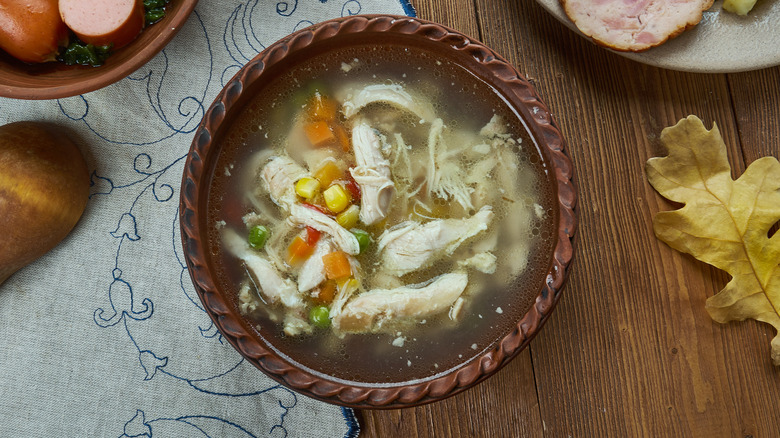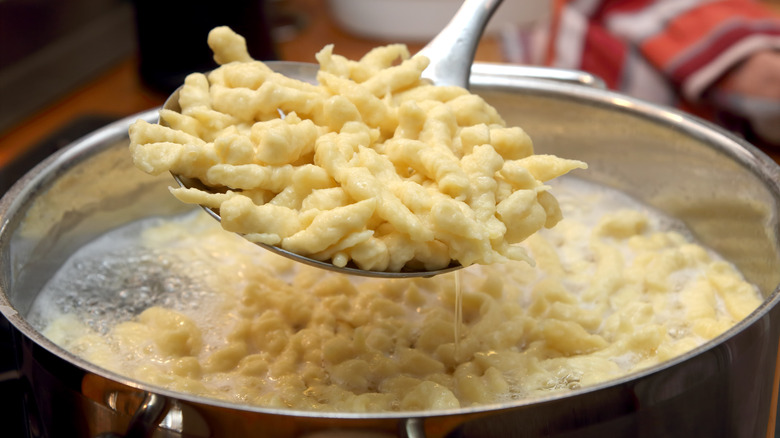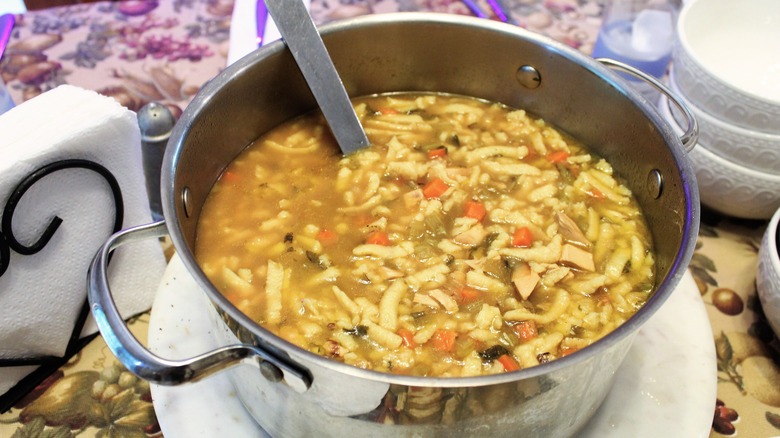What Is Rivel Soup And What Does It Taste Like?
Rivel soup is a staple of Dutch Pennsylvanian and Amish Mennonite cooking in America, based on the timeless combination of broth and dumplings. An incredibly simple but deeply warming dish made with minimal and easily available pantry ingredients, the cook's choice of broth is the first deciding factor in what it tastes like.
Chicken broth is the go-to base, but any homemade stock or store-bought base — whether meaty with pork or beef bones, or vegetarian — gives rivel soup its basic flavor, ready to be zhuz'd up with poached meat, vegetables, herbs, and other seasonings of choice. The most common additions are corn, potatoes, or onion, as well as whatever meat was used to flavor the stock. As you might expect, it's flavor is pretty close to a classic chicken noodle soup.
After the broth, the defining characteristic of rivel soup is — wait for it — the rivel. A small dumpling, its dough is made with flour, egg, and salt, before being dropped directly into the hot soup to cook in minutes. Though they add a pleasingly chewy textural contrast, much like a spätzle or matzo ball, they're not really there for the flavor. The broth and added ingredients take care of that, with the rivels used to fill out the heartiness of the dish.
The surprising origins of rivel soup
While Pennsylvania Dutch and Amish culture was established in America as early as the 1600s, rivel soup came to prominence in the 1880s and into the Great Depression, thanks to its reliance on inexpensive and readily available ingredients.
The rivel dumplings are descendants of spätzle, the German dumpling also made with egg, flour, and salt. Like rivels, spätzle are traditionally shaped by hand before being cooked in boiling salted water or broth, but the use of mechanised presses or even potato ricers is now more common.
Rivel soup may even derive from an even older German soup, eingelaufen, which translates to "shrunken." This soup, which uses a batter of flour, salt, and egg for its dumplings, is also known as riwwelsuppe, or riebelsuppe, in parts of Southern Germany. This gives rivels an unlikely connection to a classic sweet preparation: "riwwel" is a dialect variation on "streusel," the word for crumbs now known worldwide as a sweet, crunchy topping for desserts.
Rivel soup has siblings all over the world
Though occasionally found on bar and restaurant menus as a special in contemporary Pennsylvania, rivel soup is more of a nostalgic, homestyle recipe. Its comforting formula is shared not just with spätzle, but with other international preparations that cook doughs directly in hot broth, like Italian passatelli in brodo, Romanian turnatei, or Polish lane kluski. It's also related to even simpler soups that use merely egg, like stracciatella in Italy and egg drop soup in China.
There are also variations within the Pennsylvania Dutch and Amish interpretations of rivel soup. One Amish version doesn't use broth at all, but rather water or milk, adding just potato and onion for flavor along with the rivels. While the soup's original appeal lies in being economical, for home cooks today, this simplicity is an invitation to riff on the elements, whether in the choice of broth or even augmenting the rivels to taste with herbs and spices.


